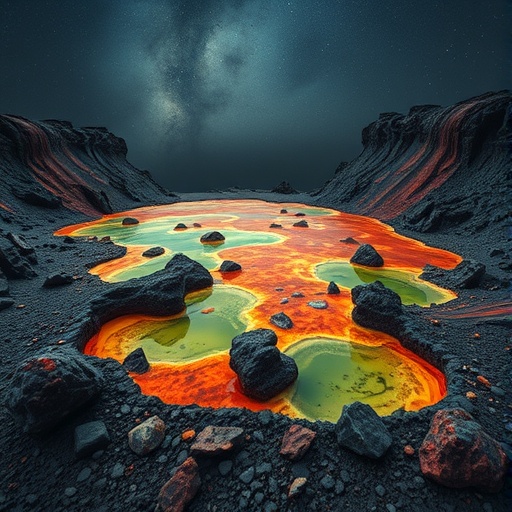In a groundbreaking study published in Nature, researchers reveal compelling evidence of complex redox-driven mineral and organic associations within the Bright Angel formation of Jezero Crater on Mars. This work sheds new light on the early Martian sedimentary environment, highlighting not only the intricate interplay between iron and sulfur chemistry but also the tantalizing possibility of past biological activity on the Red Planet.
Chemical and sedimentological analyses identify a dynamic system where oxidized iron- and phosphorus-bearing sediments underwent subsequent reduction and mobilization, resulting in the formation of divalent iron (Fe²⁺) and reduced sulfur species. These processes fostered the precipitation of unique authigenic mineral assemblages, including vivianite—a ferrous iron phosphate—as well as iron sulfides. Notably, phosphate, initially adsorbed on grains rich in ferric iron (Fe³⁺), aluminum, and silicon, was later reorganized into vivianite nodules and reaction front rims, demonstrating a closed-system geochemical reconfiguration deep within the sediment.
The mineralogical signature of these nodules is particularly remarkable due to the absence of aluminum phosphates such as variscite or strengite, which generally form under acidic, oxidizing conditions mobilizing both Al³⁺ and Fe³⁺ ions. Instead, the environmental conditions inferred here were slightly reducing and moderately acidic, favoring the transport and precipitation of ferrous iron, zinc, and phosphate ions without mobilizing aluminum. This geochemical milieu is consistent with vivianite precipitation, a mineral rarely associated with extraterrestrial sedimentary environments until now, and one that may hold vital clues about the redox history of the martian subsurface.
Further linking the mineral phases to organic inputs, the Bright Angel formation exhibits undeniable spatial associations between Fe-phosphate minerals and preserved organic matter. Oxidation of this organic matter could drive the reductive dissolution of Fe³⁺ in sediment grains, releasing both Fe²⁺ and phosphate into pore waters, and thus facilitating vivianite precipitation. Parallel processes are thought to explain Mn–phosphate nodules in Gale Crater and Fe-phosphate grains in Jezero’s Western Fan, demonstrating that abiotic and biotic redox chemistry plays a significant role in Martian geochemical transformations.
In addition to iron-phosphate minerals, iron sulfides form in specific locales such as the Apollo Temple target and reaction front cores in Cheyava Falls. Here, sulfate reduction coupled with organic matter oxidation likely contributed to iron-sulfide precipitation. As these reduced iron and sulfur phases accumulate, they drastically alter sediment color, bleaching originally red mudstones in proportion to the availability of organic material. These subtle color variations, visible as reaction fronts and nodules, serve as visual proxies for underlying redox processes in the subsurface.
The authors rigorously examine a null hypothesis that posits solely abiotic reactions underpinning these mineral assemblages. Laboratory studies demonstrate that organic carbon compounds can facilitate the abiotic reductive dissolution of ferric iron oxides at low temperatures common in sedimentary diagenesis. Abiotic oxidation of pyrite by dissolved Fe³⁺ could theoretically produce the necessary Fe²⁺; however, requisite conditions such as acidic pH and detrital pyrite presence are not observed in the Bright Angel formation, limiting this pathway’s plausibility.
Furthermore, the genesis of dissolved sulfide required for authigenic Fe-sulfide faces its own conundrum. While magmatic degassing of sulfur-bearing gases could supply sulfide, geological evidence argues against proximate hydrothermal or magmatic sulfide sources in the depositional region. Abiotic sulfate reduction by organic matter, although possible, is kinetically and energetically unfavorable at the relatively low temperatures and burial depths inferred for this environment. The absence of thermal maturation or deeply buried strata thus challenges purely abiotic sulfur cycling scenarios.
Against this backdrop, the study explores an alternative biological model deeply rooted in terrestrial analogs. On Earth, vivianite nodules and iron sulfide minerals frequently originate from microbial iron and sulfate reduction pathways. Microbial metabolisms harness oxidized iron and sulfate as terminal electron acceptors during organic matter degradation, precipitating distinctive mineral products under low-temperature, ferruginous conditions. The observed coexistence of zinc enrichment within nodules further supports a hybrid biogeochemical mechanism linking iron and sulfur cycles.
The Bright Angel formation’s reaction fronts, defined by localized bleaching and iron oxide removal, bear resemblance to well-documented terrestrial ‘reduction halos’ and ‘reduction spots.’ Such structures are often considered fossilized signatures of microbial activity, though interpretations remain debated. Importantly, these features on Mars provide potential biosignatures: geological artifacts consistent with biological processes yet requiring further multidisciplinary investigation to confirm biological origin conclusively.
Under the proposed biological framework, organic carbon—either produced abiogenically or delivered via exogenic sources—could have powered microbial iron and sulfate reduction, simultaneously oxidizing organics and precipitating Fe²⁺-phosphate and Fe-sulfide minerals. The spatial distribution and chemical zonation of nodules versus reaction fronts suggest sequential diagenetic reactions, where iron reduction initiates mineral formation which subsequently allows microbial sulfate reducers to flourish as iron becomes depleted, visible as sulfide-rich cores in reaction fronts.
This holistic view positions the Bright Angel formation as a key sedimentary archive preserving both mineralogical and organic evidence of redox transformations potentially mediated by early Martian life. The researchers underscore that these mineral-organic associations fulfill criteria of ‘potential biosignatures’—features consistent with biological activity but not yet definitively diagnostic, thus motivating further in situ measurements and sample return to Earth for comprehensive analyses.
Their findings herald a critical advance in Mars exploration by demonstrating that redox-driven mineral assemblages intimately linked to organic matter can form in habitable, low-temperature aqueous environments, reflecting processes akin to those that shaped early Earth. This raises profound implications for the search for extraterrestrial life, emphasizing that integrated geochemical and organic analyses within sedimentary deposits are vital to interpreting planetary habitability and biosignature preservation.
Looking forward, the study advocates for continued multidisciplinary research combining field analog studies, laboratory experiments, and computational models to unravel the complexities of Martian sediment redox chemistry. Moreover, the upcoming return of samples from the Bright Angel formation, notably the Sapphire Canyon sample gathered by the Perseverance rover, promises unprecedented opportunities to dissect these mineral and organic associations in terrestrial laboratories, potentially unlocking definitive evidence about the presence or absence of past life on Mars.
Ultimately, the work provides a compelling narrative of Mars as a planet where geochemical and, possibly, biological processes intertwine to sculpt intricate mineral features. Such findings elevate the Bright Angel formation to a premier target for astrobiological investigations and affirm the profound scientific value of continued exploration and sample retrieval missions. This research not only challenges conventional interpretations of Martian sedimentation but also redefines the pathways by which life’s footprints might endure on worlds beyond Earth.
Subject of Research:
Redox-driven mineral and organic associations in ancient sedimentary deposits of Jezero Crater, Mars, highlighting potential biosignatures and biogeochemical processes.
Article Title:
Redox-driven mineral and organic associations in Jezero Crater, Mars.
Article References:
Hurowitz, J.A., Tice, M.M., Allwood, A.C. et al. Redox-driven mineral and organic associations in Jezero Crater, Mars. Nature 645, 332–340 (2025). https://doi.org/10.1038/s41586-025-09413-0
Image Credits: AI Generated
DOI: https://doi.org/10.1038/s41586-025-09413-0
Keywords:
Mars sedimentology, redox chemistry, iron phosphate minerals, vivianite, iron sulfides, sulfate reduction, organic matter, potential biosignatures, Jezero Crater, microbial metabolism analogs, astrobiology, mineral diagenesis
Tags: authigenic mineral assemblages on Marsiron and sulfur chemistry on MarsJezero crater geologyMars exploration and mineralogyMartian geochemical processesorganic compounds in Martian sedimentspast biological activity on Marsphosphorus-bearing minerals in Martian soilRedox minerals on Marsreducing conditions on Marssedimentary environment of Jezero Cratervivianite formation in Jezero





